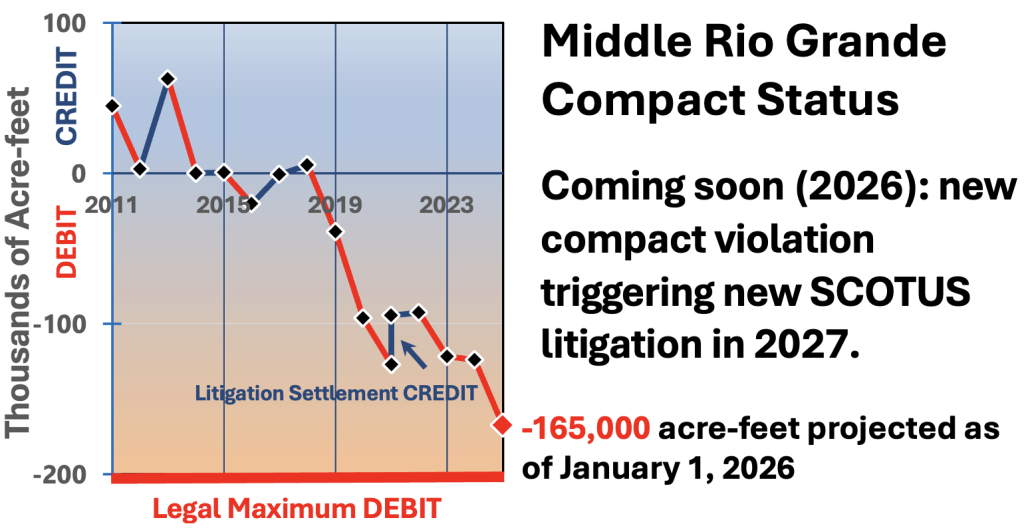Middle Rio Grande Compact Deliveries & Water Delivery Debt
New Mexico’s water situation is deteriorating; under the Rio Grande Compact, NM is accruing historic water delivery debt. This reveals a clear leadership failure in protecting New Mexico’s water.
As would be expected with a dry Rio Grande riverbed aggravated by uncontrolled diversions and groundwater pumping, the September compact compliance news is bad. According to the Bureau of Reclamation’s water accounting model, New Mexico’s water delivery arrears increased to -52,100 acre-feet as of midnight on September 29. Reclamation can’t provide the end of September figures because the federal government is shut down.
Projection of Future Water Delivery Debt
Unless we experience a weather miracle, namely the remnants of a hurricane crossing the Middle Rio Grande, I estimate that by the end of 2025, cumulative water delivery debt will be about -165,000 acre-feet. New Mexico’s increasing debt trend will look like this.

My experience as Interstate Stream Commission Director (1997-2002) and “engineer advisor” to the New Mexico Commissioner, Rio Grande Compact Commission and my license as a retired water resources engineer qualify me to publish this projection. Time will tell if it is accurate.
The Urgent Need for Courage & Transparency
The Interstate Stream Commission Director’s September 18 staff report cites only the official compact debt as of January 1, 2025:
Rio Grande Compact Status – New Mexico’s cumulative Compact debit status is 124,000 acre-feet and Article VII restrictions continue to be in effect.
Nothing was said at the Commission’s September 18 public meeting about the Water and Natural Resources Committee’s September 12th meeting. Legislators charged that New Mexico water agencies lack courage and urgency to confront the imminent new new compact violation and prevent it.
Preventing this imminent new Rio Grande Compact violation requires the leaders of these agencies to tell us the transparent truth. No major New Mexico water problem can be solved until it is publicly named and described.
Legal Authority: State Engineer & Statutes
The State Engineer must act as the law Section 72-2-9.1 NMSA 1978 (2003) requires and the State Engineer’s 2004 regulations describe. These regulations are enforceable administrative law. The 2003 law is clear:
The legislature recognizes that the adjudication process is slow, the need for water administration is urgent, compliance with interstate compacts is imperative and the state engineer has authority to administer water allocations in accordance with the water right priorities recorded with or declared or otherwise available to the state engineer.
The state engineer shall adopt rules for priority administration to ensure that authority is exercised.
This law and the associated regulations were written to manage the illegal overuse of water Lower and Middle Rio Grande. The New Mexico Supreme Court in 2012 unanimously upheld the regulations. Successive State Engineers have not upheld this law or invoked these regulations.
Budget Battles: Legislature vs. Water Protection
Governor Michelle Lujan Grisham requested $500,000 annually from the 2025 Legislature to enforce Middle Rio Grande water rights and confront the Middle Rio Grande water overuse problem. The House Appropriations and Finance Committee under Chairman Nathan Small’s leadership refused to include that request in the budget, instead choosing to direct millions of dollars to oilfield produced water and brackish water treatment. That decision shows legislators who rightfully criticized and mocked both agencies lack of urgency are collectively guilty of the same failures.
Legislative leaders and state budget appropriators: where is your leadership to protect New Mexico’s water?
Expect 2026 to be Dry
Climate projections forecast that 2026 will be similarly dry.
Why This Matters
New Mexico’s problem isn’t so much that some people take too much, although that’s a problem, too. It’s that all surface and groundwater uses together exceed with nature deplete more river water than the Middle Rio Grande’s legal share. Every extra diversion comes out of the water owed downstream. If we keep doing that, the question of how to get the Lower Rio Grande it’s entitled share to Elephant Butte will no longer be ours to decide. The U.S. Supreme Court will decide for us, with absolute discretion. They would order whatever it takes, even turning the Rio Grande into a controlled delivery canal like downstream.
That’s why it matters. That’s why we must eliminate Middle Rio Grande depletions of water owned downstream and work our way out of compact debt.
The Rio Grande Compact is a perfect barrier protecting the Middle Rio Grande from downstream users demands, but only if New Mexico complies.


October 7, 2025 @ 7:25 pm
SI’